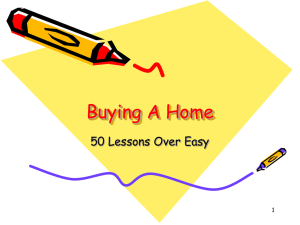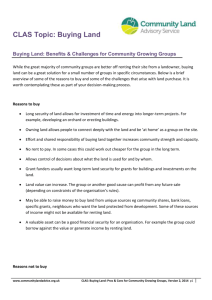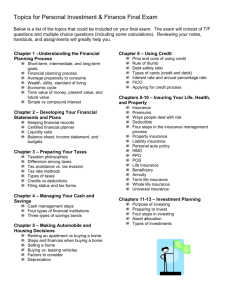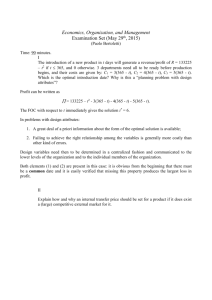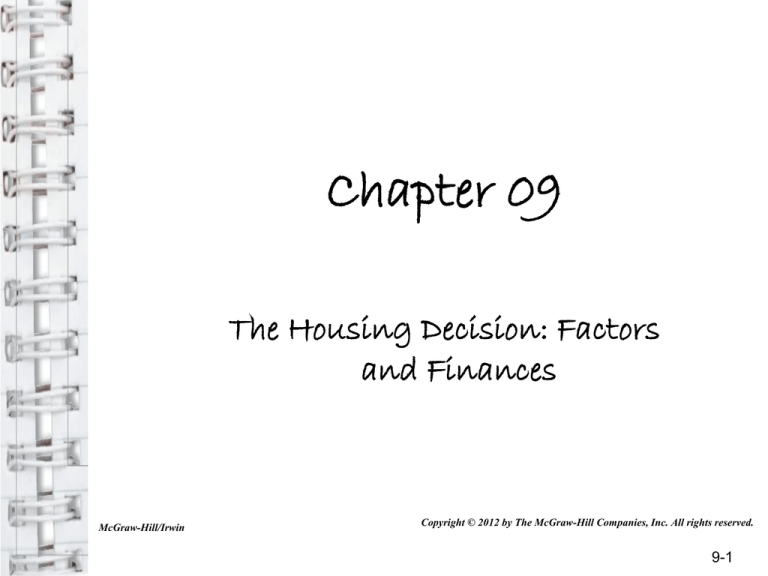
Chapter 09
The Housing Decision: Factors
and Finances
McGraw-Hill/Irwin
Copyright © 2012 by The McGraw-Hill Companies, Inc. All rights reserved.
9-1
Chapter 9
Learning Objectives
1.
Evaluate available housing alternatives
2.
Analyze the costs and benefits associated with renting
3.
Implement the home-buying process
4.
Calculate the costs associated with purchasing a
home
5.
Develop a strategy for selling a home
9-2
Housing Alternatives by life stage
9-3
Housing Alternatives
Objective 1: Evaluate available housing
alternatives
• Your lifestyle and your choice of housing
– How you spend your time and money, affects your
housing choice.
– Personal preferences are modified by financial
factors.
• Traditional financial guidelines suggest you
spend no more than 25-33% of take-home pay
on housing, or no more than 2 1/2 times your
annual income.
9-4
Housing Alternatives (continued)
• Opportunity costs of housing choices
– Interest earnings lost on money used for a down
payment or the interest on a security deposit for
an apartment
– Time and cost of commuting to live in an area
that offers less costly housing or more space
9-5
Housing Alternatives (continued)
• Opportunity costs of housing choices (continued)
– Renters lose tax advantages and equity growth
– Time and money you spend to repair and
improve a lower-priced home
– Time and effort when you have a home built to
your personal specifications
9-6
Renting-the process
9-7
Renting your Residence
Objective 2: Analyze the costs and benefits
associated with renting
• The search
– Select an area and rental cost for your needs
– Compare costs and facilities between units
– Talk to current and past residents
9-8
Renting your Residence
• Advantages of renting
– Easier to move
– Fewer maintenance and repair responsibilities
– Lower initial costs
9-9
Renting your Residence (continued)
• Disadvantages of renting
– No tax benefits
– Limitations regarding remodeling
– Restrictions regarding pets and other activities
– Legal concerns of a lease
– Costs including a security deposit, utilities and
renter’s insurance
9-10
Renting your Residence (continued)
LEGAL DETAILS OF A LEASE
• Description and address of property
• Name and address of the owner/landlord (lessor)
• Name of tenant (lessee)
• Effective date and length of the lease
• Amount of security deposit
• Amount and due date of rent
9-11
Renting your Residence (continued)
• LEGAL DETAILS OF A LEASE (continued)
• Location where rent is due
• Date and amount for late rent payments
• List of included utilities, appliances
• Restrictions on certain activities
• The right to sublet the unit
• Conditions where landlord may enter rental unit
9-12
Home Buying Process
9-13
Home Buying Process
Objective 3: Implement the home-buying process
Step 1: DETERMINE THE HOMEOWNERSHIP
NEEDS
• Benefits of Home Ownership
– Pride of ownership
• “American dream”
– Financial benefits
• Deduct property taxes and mortgage interest
• Potential increase in value of your home
• Building equity in your home
– Lifestyle flexibility - express your individuality
9-14
Home Buying Process (continued)
• Drawbacks of Homeownership
– Financial uncertainty
• Obtaining money for the down payment
• Obtaining mortgage financing
• Home values could drop
– Limited mobility
• Can take time to sell your home
– Higher living costs
• Home improvements
• Rising real estate taxes
9-15
Home Buying Process (continued)
• Assess Types of Housing Available
– Single-family dwelling
– Multi-unit dwelling
• Duplex, townhomes
– Condominium
• You own your unit in a building of units
• It is not a type of building structure, but rather a
form of homeownership
– Cooperative housing
• Non-profit organization - members own shares
and rent a unit in a building with multiple units
9-16
Home Buying Process (continued)
– Manufactured homes
• Fully or partially assembled in a factory, and then
moved to the housing site
• Prefabricated type has components built in the
factory and assembled at the site
• Mass production under factory conditions keeps
costs lower than site built homes
– Mobile homes
• A type of manufactured home, often <1,000 sq. ft.
• Offer same features as a conventional house
• Safety is debated and they tend to depreciate
9-17
Home Buying Process (continued)
• Building a home
– Does the contractor have needed
experience?
– Does contractor have a good working
relationship with architect, suppliers,
electricians, plumbers, carpenters and
others?
– What assurance do you have about
quality?
– What are the payment arrangements?
9-18
Home Buying Process (continued)
• Building a home (continued)
– What delays will be considered legitimate?
– Is the contractor licensed and insured?
– Are there any complaints about this
contractor?
– Contract should have a time schedule, cost
estimates, description of work, and a
payment schedule.
9-19
Home Buying Process (continued)
Step 2: FIND AND EVALUATE A PROPERTY
TO PURCHASE
• Selecting a Location
– Be aware of zoning laws
– Assess the school system if you have children.
9-20
Home Buying Process (continued)
Step 2: FIND AND EVALUATE A PROPERTY
TO PURCHASE (continued)
• Using a real estate agent
– They present your offer, negotiate the price,
assist you in obtaining financing, and represent
you at the closing
• Conduct a home inspection or hire an inspector
• Mortgage company will want an appraisal
9-21
Home Buying Process (continued)
Step 3: PRICING THE PROPERTY
• Determine the Home Price
– Price is affected by whether it is a seller’s or a
buyer’s market.
• Negotiating the Purchase Price
– Counteroffers are common
– Earnest money
– Contingency clauses, such as...
• Buyer must be able to obtain financing
• Sale contingent on the sale of the buyer’s
current home
9-22
The Finances of Home Buying
Objective 4: Calculate the costs associated
with purchasing a home
Step 4: OBTAIN FINANCING
• Determine the amount of the down payment
– Mortgage insurance (PMI) if less than 20% down
• Investigate the rates, types, & terms of
mortgages
• Apply for a mortgage and evaluate types of
mortgages. Guidelines for affordability of
housing costs are 33% to 38% of gross income
9-23
The Finances of Home Buying
(continued)
• Qualifying for a mortgage
– includes your income, debts, credit history, down
payment amount, length of the loan, and current
mortgage rates
– Step 1: Prequalification
– Step 2: Finding a property, including appraisal
– Step 3: Fee Payment and commitment
• Points are prepaid interest as a % of the loan
amount
9-24
The Finances of Home Buying (continued)
FIXED-RATE, FIXED-PAYMENT
MORTGAGES
• Conventional
– Fixed rate, fixed payment, amortized
– 5%, 10% or 20% down
– 15, 20 or 30 years of fixed payments
9-25
The Finances of Home Buying (continued)
• Government financing programs
– Veterans Administration
– Federal Housing Authority
– Lower down payment than conventional
• Balloon
– Fixed monthly payments plus one large
payment, usually after 3, 5 or 7 years
9-26
The Finances of Home Buying
(continued)
ADJUSTABLE-RATE, VARIABLE-PAYMENT
MORTGAGES
• Adjustable rate mortgages
– During the life of the loan the interest rate varies
with the prime rate, but has a rate cap
– A payment cap may limit the payment but,
extend the loan
9-27
Comparison of
30 and 15 Year Fixed Mortgages
• Loan Amount= $100,000
• Interest Rate=6%
Loan Term # of
(years)
payments
Payment
amount
Total cost
30
360
$600
$216,000
15
180
$843
$151,740
Total Savings=$64,260
9-28
Comparison of Different Rates
• Loan Amount= $100,000
• Loan term= 30 years (360 payments)
Interest
rate
# of
payments
Payment
amount
Total cost
7%
360
$665
$239,400
6%
360
$600
$216,000
Total Savings=$23,400
9-29
The Finances of Home Buying (continued)
OTHER FINANCING METHODS
• Buy-Downs
– Interest subsidy from a home builder or a real
estate developer that reduces the mortgage
payments for the first few years
• Second mortgage
– Home is collateral and interest may be tax
deductible. Home equity loans are an example
9-30
The Finances of Home Buying (continued)
OTHER FINANCING METHODS (continued)
• Reverse mortgages
– Provides elderly (>62 years old) with tax-free
income based on the home equity
• Refinance if interest rate drops at least 1%
9-31
The Finances of Home Buying
(continued)
Step 5: CLOSE THE PURCHASE TRANSACTION
• Documents signed; meeting of buyer, seller, and
lender
• Closing costs include...
–
–
–
–
–
–
–
Title insurance and search fee
Attorney’s and appraisers fees
Property survey; Pest inspection
Deed recording fees; Transfer taxes
Credit report; Lender’s origination fee
Escrow account for tax and insurance reserve
Pre-paid interest; Real estate commission
9-32
Selling Your Home
Objective 5: Develop a strategy for selling
• Preparing your home
– Repair, repaint, and clean
– When showing home turn on lights and open
drapes. Bake bread or make coffee for a
welcoming smell
9-33
Selling Your Home
Objective 5: Develop a strategy for selling
• Determining the selling price
– Appraiser estimates the current value
– Real estate agent markets your home
• If “for sale by owner,” use a lawyer or Title Company
• Listing with a real estate agent for services
9-34

